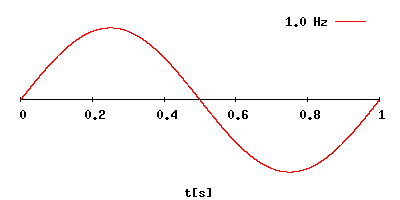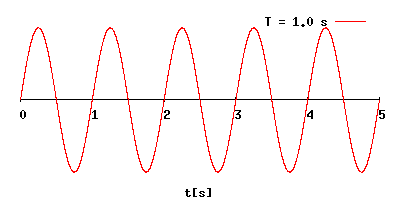
Source: Wave Frequency, Superborsuk, Wikimedia commons
There are two ways that scientists time the motion of a wave. The first is to use a stopwatch and determine how long it takes for a wave to go through its complete cycle, and the second is to count how many wave cycles happen in one second.
The two methods give different results. The first method is used to determine the period of a wave:
Period (T)—the time in seconds to complete one full wave cycle Units: Seconds (s)
The second method is used to determine the frequency of a wave:
Frequency (f)—the number of wave cycles that occur in one second Units: Hertz (Hz)
When the frequency of a wave increases, the string moves up and down more often, and the wave gets "bunched together"

Source: Wave Frequency, Superborsuk, Wikimedia commons
As the period of a wave increases, the string takes longer to move up and down, and the wave gets more spread out

Source: Wave Period, Superborsuk, Wikimedia commons
Period and frequency are reciprocal quantities: f = 1 T or T = 1 f
Examples:
A student sitting on a dock at the ocean times how long it is between crests of the incoming waves. The waves are 4 seconds apart, what is the frequency?
f = 1 T = 1 4 = 0.25Hz
A student in a physics lab uses a motion sensor to determine the frequency of a wave. The Student times for 15 seconds, and counts 300 complete waves in that time. What are the frequency and period of that wave?
f = waves seconds = 300 15 = 20 Hz
T = 1 f = 1 20 = 0.25 seconds